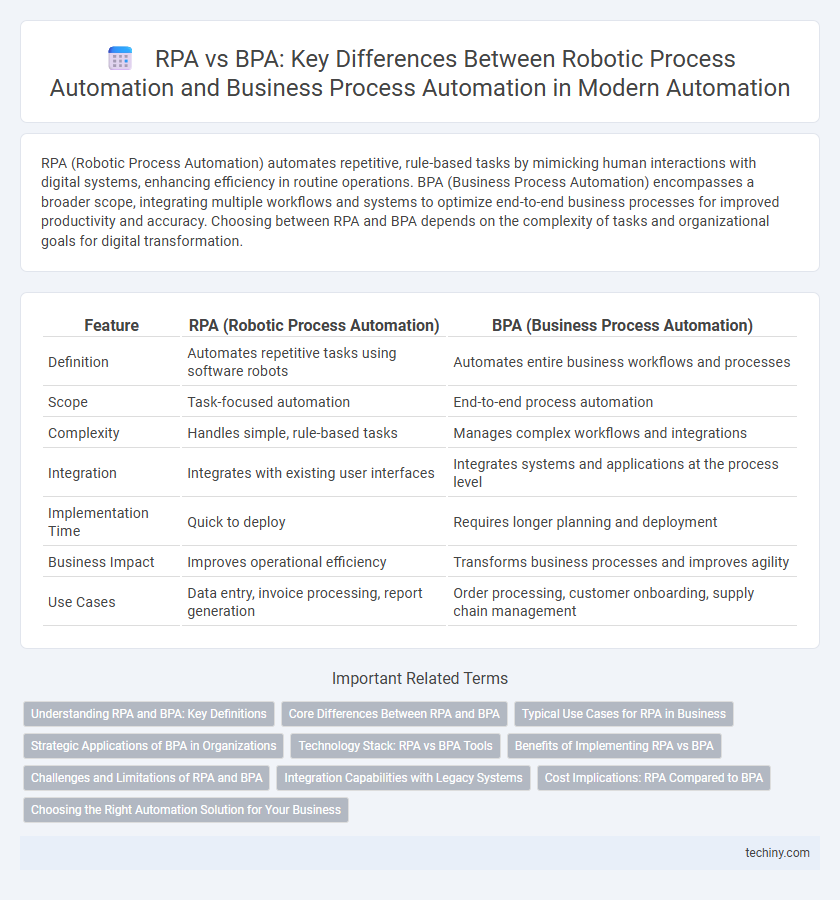RPA (Robotic Process Automation) automates repetitive, rule-based tasks by mimicking human interactions with digital systems, enhancing efficiency in routine operations. BPA (Business Process Automation) encompasses a broader scope, integrating multiple workflows and systems to optimize end-to-end business processes for improved productivity and accuracy. Choosing between RPA and BPA depends on the complexity of tasks and organizational goals for digital transformation.
Table of Comparison
| Feature | RPA (Robotic Process Automation) | BPA (Business Process Automation) |
|---|---|---|
| Definition | Automates repetitive tasks using software robots | Automates entire business workflows and processes |
| Scope | Task-focused automation | End-to-end process automation |
| Complexity | Handles simple, rule-based tasks | Manages complex workflows and integrations |
| Integration | Integrates with existing user interfaces | Integrates systems and applications at the process level |
| Implementation Time | Quick to deploy | Requires longer planning and deployment |
| Business Impact | Improves operational efficiency | Transforms business processes and improves agility |
| Use Cases | Data entry, invoice processing, report generation | Order processing, customer onboarding, supply chain management |
Understanding RPA and BPA: Key Definitions
Robotic Process Automation (RPA) focuses on automating repetitive, rule-based tasks using software bots that mimic human actions, enhancing efficiency in specific workflows. Business Process Automation (BPA) encompasses a broader strategy that streamlines complex business processes through integration of tools, technologies, and workflows to optimize overall operational performance. Understanding the distinctions between RPA and BPA is essential for organizations aiming to leverage automation for improving productivity and reducing costs effectively.
Core Differences Between RPA and BPA
Robotic Process Automation (RPA) focuses on automating repetitive, rule-based tasks using software robots that mimic human actions, primarily interacting with existing user interfaces. Business Process Automation (BPA) involves a broader strategy that streamlines entire workflows and integrates multiple systems to improve overall business efficiency and decision-making. RPA tends to address task-level automation, while BPA targets full end-to-end process optimization across organizational functions.
Typical Use Cases for RPA in Business
Robotic Process Automation (RPA) is commonly deployed for repetitive, rule-based tasks such as data entry, invoice processing, and customer service automation, enabling businesses to reduce manual errors and increase operational efficiency. Typical use cases include automating routine back-office functions like payroll, order processing, and compliance reporting, where RPA bots interact with multiple applications without altering existing systems. Unlike Business Process Automation (BPA), which reengineers entire workflows, RPA focuses on mimicking human interactions with software to accelerate process execution in discrete, repetitive tasks.
Strategic Applications of BPA in Organizations
Business Process Automation (BPA) streamlines complex workflows by integrating multiple systems and applications, enabling end-to-end automation of organizational processes beyond repetitive tasks addressed by Robotic Process Automation (RPA). BPA strategically enhances operational efficiency, reduces errors, and supports decision-making through intelligent data analytics and process optimization. Organizations adopting BPA experience improved agility, scalability, and alignment of automation initiatives with broader business goals, driving sustained competitive advantage.
Technology Stack: RPA vs BPA Tools
RPA tools primarily leverage software bots to automate repetitive, rule-based tasks with technologies like screen scraping, AI, and machine learning integration, while BPA solutions encompass broader enterprise systems integrating workflows, ERP, CRM, and data analytics platforms. RPA platforms such as UiPath, Blue Prism, and Automation Anywhere focus on task-level automation with user-friendly interfaces, whereas BPA tools like Nintex, Appian, and Pega provide end-to-end process orchestration and complex business logic automation. Organizations select RPA for rapid deployment in specific areas, while BPA suits comprehensive digital transformation strategies requiring scalable, cross-departmental process optimization.
Benefits of Implementing RPA vs BPA
RPA (Robotic Process Automation) delivers rapid deployment and scalability by automating repetitive, rule-based tasks across applications without altering existing systems, enhancing accuracy and reducing operational costs significantly. BPA (Business Process Automation) offers comprehensive workflow optimization by integrating complex processes and improving cross-departmental collaboration, driving overall business efficiency and compliance. Implementing RPA enables faster ROI through task-specific automation, while BPA supports long-term strategic transformation by streamlining end-to-end business processes.
Challenges and Limitations of RPA and BPA
RPA faces challenges like limited scalability, high maintenance due to rule-based scripting, and difficulty handling unstructured data, which reduces its effectiveness in complex workflows. BPA offers broader process integration but encounters limitations in cost, complexity, and longer implementation times, making rapid adaptation harder. Both RPA and BPA require ongoing monitoring and frequent updates to align with evolving business processes and compliance standards.
Integration Capabilities with Legacy Systems
RPA excels in integrating with legacy systems by mimicking human interactions on the user interface, enabling quick deployment without altering existing infrastructures. BPA offers deeper integration through APIs and workflow orchestration, automating end-to-end processes and enhancing system interoperability. Both approaches improve operational efficiency, but RPA is ideal for surface-level tasks, while BPA delivers comprehensive backend automation.
Cost Implications: RPA Compared to BPA
RPA (Robotic Process Automation) typically incurs lower upfront costs due to its ability to automate repetitive tasks without requiring extensive changes to existing systems, making it cost-effective for short-term gains. BPA (Business Process Automation), while involving higher initial investments in integrated software solutions and process redesign, offers greater long-term savings through comprehensive workflow optimization and scalability. Organizations should evaluate total cost of ownership, including maintenance and potential productivity improvements, when choosing between RPA and BPA for automation strategies.
Choosing the Right Automation Solution for Your Business
RPA (Robotic Process Automation) excels in automating repetitive, rule-based tasks across multiple applications without altering existing systems, making it ideal for quick deployment and cost efficiency. BPA (Business Process Automation) offers a comprehensive approach by streamlining entire workflows and integrating complex processes, enhancing overall business agility and scalability. Selecting the right automation solution depends on evaluating task complexity, integration needs, and long-term strategic goals to maximize operational efficiency and ROI.
RPA (Robotic Process Automation) vs BPA (Business Process Automation) Infographic

 techiny.com
techiny.com